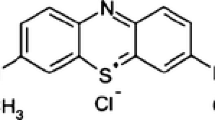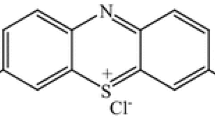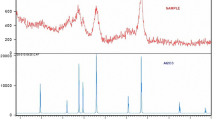Abstract
In this research, ZnAl2O4/Al2O3 nanocomposites with different ZnAl2O4 (30, 50, and 70 wt.%) were successfully prepared in one step by sol–gel method and utilized for the removal of methylene blue (MB). The structural properties of nanocomposites were investigated by X-ray diffraction (XRD), differential thermal analysis (DTA), FTIR analysis, Zeta potential, and BET. The obtained results showed the synthesized nanocomposites by sol–gel method were amorphous and heat treatment at 700 °C led to the crystallization of zinc aluminate spinel. The maximum MB removal (70%) was obtained under o9 ptimal conditions such as initial concentration of MB (10 mg/L), pH of solution (8.5), the amount of adsorbent (0.05 g), type of adsorbent (70 wt.% ZnAl2O4/Al2O3 nanocomposite). The average size of zinc aluminate crystals in the maximum amount of zinc aluminate in the composite (70 wt.%) was calculated to be 27 ± 1 nm and its morphology changed from sheet to mass. The specific surface area of the nanocomposite was calculated to be 70 m2/g. The kinetics of adsorption was fitted with the pseudo-second order model.

Highlights
-
ZnAl2O4/Al2O3 nanocomposites with different ZnAl2O4 were synthesized in one step by sol–gel method.
-
The specific surface area of Al2O3 –70 wt.% ZnAl2O4 nanocomposite was calculated to be 70 m2/g.
-
The highest adsorption efficiency MB (72%) was obtained from 10 mg/L initial solution.










Similar content being viewed by others
References
Sukul G, Balaramakrishna PV (2014) Novel ZnAl2O4:SiO2 nano-composites for high temperature refractory applications. Mater Sci Eng 64:1–6
Tzing WS, Tuan WH (1996) The strength of duplex AI2O3-ZnAI2O4 composite. J Mater Sci Lett 15:1395–1396
Zhang L, Yana J, Zhou M, Yang Y, Liu YN (2013) Fabrication and photocatalytic properties of spheres-in-spheres ZnO/ZnAl2O4 composite hollow microspheres. Appl Surf Sci 268:237–245
Sommer S, Bøjesen ED, Reardon H, Iversen BB (2020) Atomic scale design of spinel 4. ZnAl2O4 nanocrystal synthesis. Crys Growth Des 20:1789–1799
Dutta K, Das S, Pramanik A (2012) Concomitant synthesis of highly crystalline Zn–Al layered double hydroxide and ZnO: phase interconversion and enhanced photocatalytic activity. J Colloid Interface Sci 366:28–36
Stringhini FM, Foletto EL, Sallet D, Bertuol DA, Filho OC, Nascimento CAO (2014) Synthesis of porous zinc aluminate spinel (ZnAl2O4) by metal-chitosan complexation method. J Alloy Compd 588:305–309
Zidouh H, Ait Baih M, El Qacemi N, Mamouni R, Laknifl A, Saffaj N (2019) Wastewater treatment by ZnAl2O4 ultrafiltration ceramic membrane. Int J Mater Sci 2:99–105
Zhaoxia B, Rong Z, Weiping L, Xusheng W, Shulin G, Bo S, Yi S, Zhiguo L, Youdou Z (2003) Synthesis of ZnAl2O4/Al2O3 complex substrates and growth of GaN films. Sci China 46:42–46
Foletto EL, Battiston S, Simoes JM, Bassaco MM, Pereira LSF, Flores EMM, Muller EI (2012) Synthesis of ZnAl2O4 nanoparticles by different routes and the effect of its pore size on the photocatalytic process. Microporous Mesoporous Mater 163:29–33. 2012
Ianos R, Borcanescu S, Lazau R (2014) Large surface area ZnAl2O4 powders prepared by a modified combustion technique. Chem Eng J 240:260–263. 2014
Zhu Z, Li X, Zhao Q, Liu S, Hu X, Chen G (2011) Facile solution synthesis and characterization of porous cubic-shaped superstructure of ZnAl2O4. Mater Lett 65:194–197
Meena AK (2006) Studies on treatment of contaminated water containing heavy metals in Jaipur and Pali”, Ph.D. thesis, University of Rajasthan, India
Tao P, Shao M, Song CH, Wu SH, Cheng M, Cui ZH (2014) Preparation of porous and hollow Mn2O3 microspheres and their adsorption studies on heavy metal ions from aqueous solutions. J Ind Eng Chem 20:3128–3133
Joyner RW (1991) Principles of catalyst development. Adv Mater 3:170–171. 1991
Farhadi S, Jahanaram K (2014) ZnAl2O4@SiO2 nanocomposite catalyst for the acetylation of alcohols, phenols and amines with acetic anhydride under solvent‐free conditions. Chin J Catal 35:368–375
Motloung S, Dejene F, Swart H, Ntwaeaborwa O (2011) Sol-gel synthesis and characterization of structural and luminescence properties of ZnAl2O4 doped with Mn2+ powder phosphor. J Mater Sci 46:6981–6987
Ramesh S (2013) Sol-gel synthesis and characterization of Ag3(2+x)AlxTi4−xO11+ δ (0.0 ≤ x ≤ 1.0) nanoparticles. J Nanosci 2013:1–8
Wang SF, Sun GZ, Fang LM, Lei L, Xiang X, Zu XT (2015) A comparative study of ZnAl2O4 nanoparticles synthesized from different aluminum salts for use as fluorescence materials. Sci Rep. 5:1–12. 2015
Sing SW, Everett DH, Haul RAW, Moscou L, Pierotti RA, Rouquerol J, Siemieniewska T (1985) Reporting physisorption data for gas/solid systems, with special reference to the determination of surface area and porosity. Pure Appl Chem 57:603–619
Royer B, Cardoso NF, Lima EC, Vaghetti JCP, Simon NM, Calvete T, Veses RC (2009) Applications of Brazilian-pine fruit shell in natural and carbonized forms as adsorbents to removal of methylene blue from aqueous solutions- kinetic and equilibrium study. J Hazard Mater 164:1213–1222
Mahmoud MS, Farah JY, Farrag TE (2013) Enhanced removal of Methylene Blue by electrocoag ulation using iron electrodes. Egypt J Pet 22:211–217
Anbia M, Asl Hariri S (2010) “Removal of methylene blue from aqueous solution using nanoporous SBA-3. Desalination 261:61–66
Gulnaz O, Sahmurova A, Kama S (2011) Removal of Reactive Red 198 from aqueous solution by Potamogeton crispus. Chem Eng J 174:579–585
Kushwaha AK, Gupta N, Chattopadhyaya MC (2014) Removal of cationic methylene blue and malachite green dyes from aqueous solution by waste materials of Daucus carota. J Saudi Chem Soc 18:200–207
Nezam A, Saffar-Teluri A, Hassanzadeh-Tabrizi SA (2016) The high efficiency of Al2O3–SiO2–CuO nanocomposites as an adsorbent: synthesis and dye removal efficiency. Res Chem Intermd 42:4999–5011
Ni ZM, Xia SJ, Wang LG, Xing FF, Pan GX (2007) Treatment of methyl orange by calcined layered double hydroxides in aqueous solution: adsorption property and kinetic studies. J Colloid Interface Sci 316:284–29
Sujoy KD, Bhowal J, Akhil RD, Guha AK (2006) Adsorption behavior of rhodamine B on Rhizopus oryzae biomass. Langmuir 22:7265–7272
Delrio A. I, Fernandez J, Molina J, Bonastre J, Cases F (2011) Electrochemical treatment of a synthetic wastewater containing a sulphonated azo dye. Determination of naphthalenesulphonic compounds produced as main by-products. Desalination 273:428–435
Motlagh MM, Hassanzadeh-Tabrizi SA, Saffar-Teluri A (2015) Sol–gel synthesis of Mn2O3/Al2O3/SiO2 hybrid nanocomposite and application for removal of organic dye. J Sol-Gel Sci Technol 73:9–13
Bouzid H, Rabiller-Baudry M (2008) Impact of zeta potential and size of caseins as precursors of fouling deposit on limiting and critical fluxes in spiral ultrafiltration of modified skim milks. J Membr Sci 314:67–75
Azizian S (2004) Kinetic models of sorption: a theoritical study. J Colloid Interface Sci 276:47–52
Ofomaja AE (2010) Intraparticle diffusion process for lead (II) biosorption onto mansonia wood sawdust. Bioresour Technol 101:5868–5876
Wang S, Boyjoo Y, Choueib A (2005) A comparative study of dye removal using fly ash treated by different methods. Chemosphere 60:1401–7
Saffar A, Abbastabar Ahangar H, Aghili A, Hassanzadeh-Tabrizi SA, Aminsharei F, Rahimi H, Alikhani Kupai J (2020) Synthesis of the novel CuAl2O4–Al2O3–SiO2 nanocomposites for the removal of pollutant dye and antibacterial applications. Res Chem Intermed 47:599–612
Rauf MA, Shehadeh I, Ahmed A, Al-Zamly A (2009) Removal of methylene blue from aqueous solution by using gypsum as a low cost adsorbent. World Acad Sci Eng Technol 31:604–609
Alzaydien AS (2009) Adsorption of methylene blue from aqueous solution onto a low-cost natural Jordanian Tripoli. Am. J Environ Sci 5:197–208
Author information
Authors and Affiliations
Corresponding author
Ethics declarations
Conflict of interest
The authors declare no competing interests.
Additional information
Publisher’s note Springer Nature remains neutral with regard to jurisdictional claims in published maps and institutional affiliations.
Rights and permissions
About this article
Cite this article
Saffar, A., Ahangar, H.A., Salehi, S. et al. Synthesis of novel ZnAl2O4/Al2O3 nanocomposite by sol–gel method and its application as adsorbent. J Sol-Gel Sci Technol 99, 158–168 (2021). https://doi.org/10.1007/s10971-021-05559-1
Received:
Accepted:
Published:
Issue Date:
DOI: https://doi.org/10.1007/s10971-021-05559-1




